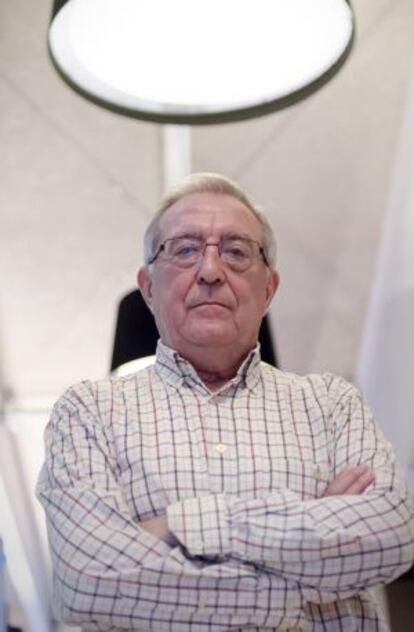Spain examines use of futuristic mind probe in missing woman case
Husband given brain impulse test as suspect in wife's disappearance


Pilar Cebrián, 51, disappeared in April 2012 in Ricla, a village of 3,000 people in the province of Zaragoza. Her husband, Antonio Losilla, waited nearly a month before reporting her missing - too long for a concerned husband. The police suspected a case of homicide and began investigating. Traces of blood found inside the garage of the family home cast an even longer shadow over Losilla, who has always been the sole suspect in the case.
The matter appeared to be solved. Then, one day in October, farmers found a semi-buried human head and an arm in the outskirts of a nearby village. The remains seemed to be Pilar Cebrián's. The judge had Losilla taken into custody, but a forensic analysis showed that the body parts belonged to a different woman altogether, a 27-year-old whose killing is being blamed on her boyfriend.
Even so, the judge decided to keep Losilla in prison. By then he had already confessed to police that he killed and quartered his wife, but later retracted, saying he made that statement without his lawyer and under duress. The case was getting more complicated. The police continued to investigate: they searched a 250-meter-deep well and interrogated the victim's daughter.
Meanwhile, Dr José Ramón Valdizán, who retired two years ago from Zaragoza's Miguel Servet Hospital after 21 years as head of the neurophysiology department, was closely following the case through the media. He thought there was something he could do to help.
For months, Valdizán had been thinking about possible police applications for the brain scanner that he had used for two decades to treat children with autism or attention deficit syndrome. "A woman is missing, and I may have a tool to help find her," he told himself.
A US scientist, Lawrence Farwell, was the first person to employ a neurological test known as brain fingerprinting in criminal investigations, 13 years ago. Valdizán thought he might introduce it in Spain. And as a result of a chance meeting, the disappearance of Pilar Cebrián is the first case that has used brain fingerprinting to detect whether her husband's head contains a record of the crime.
A year ago, as he walked down the hallways of the hospital during a visit to his former workplace, Valdizán ran into Dr Cristina Andreu, a forensic psychologist at the Institute of Legal Medicine of Aragón, a former colleague of his. During this chance encounter, Valdizán mentioned his idea to help solve the Ricla mystery. As luck would have it, Andreu, who worked in the gender violence department at the Institute, had just been sent this very case.
A few months later, Valdizán received a phone call. The police were getting impatient with the lack of progress and were interested in the test. The first meeting took place before the summer, inside the Zaragoza courthouse. Standing before legal and police representatives, Valdizán and Andreu explained how the technology works.
The brain, said Valdizán, who did most of the talking, is a great storage space, and brain fingerprinting can uncover whether Losilla's brain stores any specific details about the alleged crime. The way this is detected is through a brainwave called P300, an electrical impulse that the brain emits 300 milliseconds after a question is asked. If the individual recalls the event that he or she is being asked about, this brainwave is higher than it would be if the event were unknown.
The heads of the investigation thought it over, and a few months later, when all other avenues had been exhausted, they decided to try it out. In October, Valdizán received a second phone call. In order to convince the judge, two national police officers underwent the test. One of them was familiar with all the details of the investigation, the other was not. The results were convincing: the brainwaves proved that the former officer's brain contained specific information about the case.
On Wednesday of this week, Antonio Losilla sat inside a narrow room in Miguel Servet hospital in the company of two nurses, wearing a helmet with a dozen cables sticking out and connected to the machine and the screen showing the brainwaves. Valdizán stood on the other side of a glass wall. For 10 minutes, he was asked details about the crime that only its perpetrator should know about. The police insist that this is not a "truth machine" but just another tool to allow the investigation to move forward.
Lawrence Farwell, speaking on the phone from his office in Seattle, sounded pleasantly surprised to learn that the test was being conducted in Spain for the first time. He still clearly recalls the first time his technique was decisive in having someone convicted. It was in 2000, and involved James B. Grinder, a man accused of raping and killing Julie Helton in 1984 in Macon, Missouri. Grinder had eluded justice on many occasions, and the sheriff, who was convinced he was guilty of this and other crimes, was unable to produce conclusive evidence. So he turned to Lawrence.
Lawrence says that Grinder's apparent calm vanished as the test was being conducted. "He'd been eluding justice for 15 years, and thought he could get away with it once more. But when it was all over he admitted to his guilt, and reached a settlement with the attorney because he was afraid that the result of the test might be used as evidence in court."
The scientist says he has run the test on around 100 suspects, but that so far his method has only once been used as evidence in court. Terry Harrington was released from jail after serving 23 years for a crime he did not commit. His mind had no record of the events he was accused of and convicted for.
Farwell is ambitious about his method, which he says is 99 percent reliable. "If criminals know we can get inside their brains, they will think twice before committing a crime, because they know they will not be found innocent."
In Spain, the test has generated suspicion, surprise and interest among the parties involved in the Ricla case. Defense lawyer Javier Notívoli is appealing on the grounds that he doesn't want "experiments" run on his client, and that the test violates his right not to incriminate himself. The prosecuting lawyer, Soraya Laborda, was also caught off-guard and will only say that she is waiting to see whether the test is accepted as valid evidence in the Spanish justice system.







































